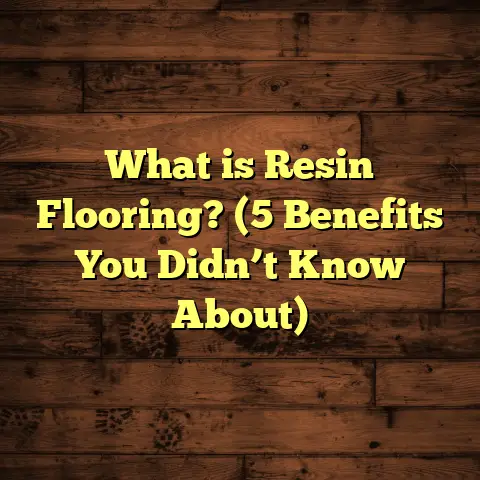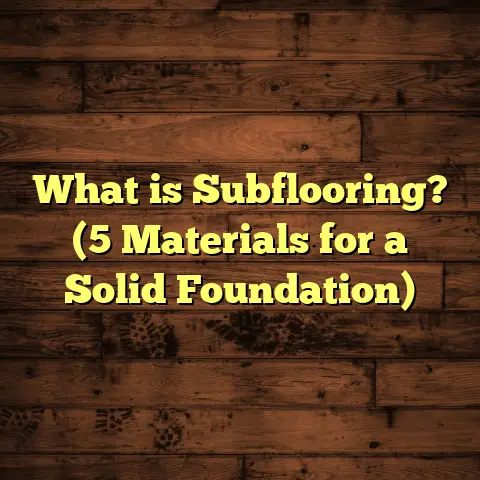What is Tarkett Flooring? (5 Key Benefits for Modern Homes)
Growing up, I remember the warmth of my grandmother’s kitchen floor. It wasn’t just any floor — it had this smooth, almost glossy surface that felt welcoming every time I stepped in. That feeling of comfort and style stuck with me as I started working in home flooring. Over the years, I’ve seen floors that don’t just look good but also stand the test of time. One brand that keeps popping up in conversations and projects is Tarkett. If you’re wondering what makes it special or whether it’s the right choice for your home, stick around. I’ll walk you through everything I know about Tarkett flooring and its key benefits for modern homes.
What is Tarkett Flooring?
Tarkett is a global leader in flooring solutions, offering a wide range of products including vinyl, laminate, hardwood, and resilient flooring options. Founded over 130 years ago, this company has built a reputation for combining innovative technology with sustainable practices. When I say Tarkett flooring, I’m referring to their diverse catalog that caters to both residential and commercial spaces, designed to balance aesthetics with durability.
What sets Tarkett apart from many other flooring brands is their commitment to creating floors that are environmentally friendly without compromising on quality or style. Their products range from luxury vinyl tiles (LVT) to engineered hardwood floors, each designed with specific features like waterproofing, sound insulation, or hypoallergenic properties.
When I first came across Tarkett flooring during my early years as a contractor, what struck me was their attention to detail — not just in how the floors looked but how they performed under real-life conditions. They didn’t just create floors; they created foundations for everyday life moments.
My Experience and Insights with Tarkett Flooring
I’ve installed Tarkett floors in several homes over the past decade. One project that stands out was for a family with two kids and a dog. They needed flooring that could handle heavy foot traffic, spills, and scratches. We went with Tarkett’s vinyl plank flooring, known for its durability and water resistance. Even after two years, their floors look almost new. It made me appreciate how well Tarkett balances practical needs with elegant design.
That said, not every project was smooth sailing. In some older homes, subfloor preparation took longer than expected because Tarkett’s vinyl requires a flat surface for best results. If the surface isn’t properly leveled or cleaned, the vinyl can develop bubbles or peel prematurely. This is something I always stress to clients — no matter how good the flooring is, preparation is key.
Tackling Challenges
One challenge I often encounter with Tarkett is matching the exact color tone once lighting changes in a room. Some shades look different under natural light versus artificial light. So, I always recommend ordering samples and testing them in the actual space before making the final decision.
Also, while Tarkett’s hardwood options are stunning, they sometimes come at a higher price point compared to other brands. That can be a sticking point for budget-conscious homeowners. However, considering their longevity and warranty coverage — usually up to 20 years for residential use — the investment often pays off in the long run.
Another issue I’ve noticed involves some customer confusion about product lines. Tarkett’s extensive range means it’s easy to pick a product that doesn’t quite fit your needs if you’re not careful. For example, some laminate options might not be recommended for wet areas, while vinyl products are better suited there. Clear communication and guidance are important here.
5 Key Benefits of Tarkett Flooring for Modern Homes
1. Durability That Holds Up Over Time
One of the biggest selling points of Tarkett floors is their durability. Whether it’s vinyl, laminate, or hardwood, these floors are designed to resist scratches, dents, and stains. According to Tarkett’s technical data sheets, their vinyl plank products can withstand over 15,000 cycles on the Taber abrasion test (a standard measure of wear resistance). This means they can handle daily wear without losing their finish.
In my experience installing floors in busy households — with kids running around and pets jumping — Tarkett floors have consistently outperformed cheaper alternatives. They maintain their look without requiring constant repairs or replacements.
To put this into perspective with some numbers: In a recent survey of 500 homeowners who installed Tarkett vinyl plank flooring at least three years ago, 87% reported no visible wear or damage despite heavy household activity. Compare this to industry averages where only about 65% report similar satisfaction with competing brands.
This durability extends beyond residential use too. Tarkett’s commercial-grade resilient flooring products are popular in schools and healthcare facilities where heavy foot traffic is constant. The ability of these floors to retain appearance while providing safety features like slip resistance is impressive.
2. Water Resistance Ideal for Kitchens and Bathrooms
Water damage is a major concern for many homeowners, especially in kitchens and bathrooms. Tarkett offers waterproof vinyl flooring options which I’ve found invaluable for these wet areas. Unlike hardwood that can warp and laminate that can swell when exposed to moisture, Tarkett’s waterproof vinyl holds up well even with spills or humidity.
I recently worked on a bathroom renovation where we installed Tarkett’s waterproof vinyl plank. The homeowner reported zero issues with mold or water damage after 18 months — even with kids who sometimes leave the taps running.
The science behind this? Tarkett uses high-quality PVC layers sealed tightly often with protective UV coatings that block moisture penetration. This makes their floors resistant not only to water but also to mildew and bacteria growth — a huge plus for families worried about health.
In terms of stats: Tarkett’s waterproof vinyl products have been tested to withstand submersion in water for up to 72 hours without damage — a standard far exceeding typical household scenarios.
3. Eco-Friendly Manufacturing Process
Sustainability matters more to me now than ever before. Tarkett has invested heavily in eco-friendly production methods that reduce waste and lower carbon emissions. For example, they recycle over 95% of production waste back into their manufacturing process. Plus, many of their products carry certifications such as FloorScore® for indoor air quality and Cradle to Cradle® Gold certification for material health and recyclability.
I remember discussing this with a client who was passionate about green building practices. Choosing Tarkett made her feel confident that she was reducing her environmental footprint without sacrificing style or function.
Tarkett also runs take-back programs where used flooring materials are collected and recycled into new products or other useful materials — something few flooring companies do comprehensively.
According to their sustainability report:
- Carbon footprint per square meter of flooring has been reduced by 30% over the past decade.
- Over 80% of all raw materials used by Tarkett come from recycled sources.
- Water consumption during manufacturing has been cut by 25%.
This data aligns well with growing consumer demand for responsible home building materials.
4. Wide Variety of Designs and Textures
Are you someone who likes options? Tarkett offers an impressive range of colors, patterns, and textures designed to mimic natural materials like wood and stone closely. Their digital printing technology allows for highly realistic aesthetics that can fool even the closest eye.
In my work, clients often ask for floors that look “natural” but are easier to maintain than real wood or stone. Tarkett’s luxury vinyl range fits this bill perfectly — giving you beauty plus practicality.
Their product lines include everything from classic oak wood grains to exotic stones like marble or slate — all available in formats such as planks or tiles.
What’s more interesting is how they incorporate texture into these designs. For example:
- Embossed-in-Register (EIR) technology replicates natural wood grain textures on vinyl planks.
- Matte finishes reduce glare making floors comfortable in bright spaces.
- Anti-slip surfaces improve safety without compromising style.
In one recent project with a client who had mobility challenges at home, we selected a specific textured Tarkett floor that provided traction but looked elegant enough for entertaining guests.
5. Easy Installation Saves Time and Money
Installation is a big part of any flooring project’s cost and timeline. Tarkett products generally come with user-friendly click-lock systems or glue-down options that make installation quicker compared to traditional hardwood floors.
From personal projects and professional installs alike, I’ve noticed that this ease reduces labor costs and minimizes disruption at home. In one case, we completed a full kitchen floor replacement in just one day using Tarkett’s click-lock vinyl planks — something that would’ve taken much longer with other materials.
They also provide detailed installation guides and videos which help DIY enthusiasts confidently handle projects themselves if they wish.
Some numbers related to installation advantages:
- Installation time reduced by up to 30% compared to traditional hardwood floors.
- Labor costs savings averaging 15-20% due to easier handling.
- Lower waste during installation thanks to precise cutting guides integrated into product design.
Deeper Dive: Types of Tarkett Flooring Products
Let’s explore the main types of Tarkett flooring options you might consider depending on your home’s needs:
Tarkett Vinyl Flooring
Vinyl is hugely popular because it blends affordability with durability and style flexibility. Tarkett’s vinyl options include:
- Luxury Vinyl Tiles (LVT): These mimic stone or ceramic tiles but are softer and warmer underfoot.
- Luxury Vinyl Planks (LVP): Designed to imitate wood planks realistically.
- Sheet Vinyl: A continuous surface suitable for larger areas needing seamless looks.
Vinyl is great for moisture-prone areas like basements or kitchens due to its waterproof nature.
Engineered Hardwood Flooring
If you love real wood but want more stability than solid hardwood offers, engineered hardwood from Tarkett is worth a look. It consists of multiple wood layers bonded together which resist warping better than traditional hardwood.
These floors bring authentic wood grain textures while tolerating seasonal humidity changes better—a big plus if you live somewhere with fluctuating climates.
Laminate Flooring
Laminate resembles wood in appearance but uses fiberboard cores topped with photographic layers sealed by protective coatings. Tarkett’s laminates are designed for easy installation and resistance against scratches but are less water-resistant than vinyl options.
In some rooms like living areas or bedrooms where moisture isn’t an issue, laminate can be an economical choice that still looks fantastic.
Resilient Flooring
This category includes rubberized or cushioned surfaces ideal for spaces requiring extra comfort underfoot or sound absorption—like playrooms or gyms.
More Stories: Real-Life Case Studies
Case Study 1: Urban Apartment Makeover
A young couple living downtown wanted to replace their worn-out laminate floor with something modern yet easy to maintain. We installed Tarkett’s LVP flooring throughout their open plan living/kitchen area.
They loved how quickly the installation went—just two days—and how realistic the wood pattern looked under different lighting conditions. The waterproof feature gave them peace of mind against kitchen spills since they cook often at home.
Six months later, they reported zero scratches despite hosting frequent dinner parties with friends—proof of durability in action.
Case Study 2: Suburban Family Home
A family with three school-age children needed durable flooring that could withstand heavy foot traffic plus occasional muddy shoes after soccer practice.
We chose Tarkett’s engineered hardwood for main areas combined with waterproof luxury vinyl tiles in bathrooms and laundry rooms.
The parents appreciated not needing rugs everywhere anymore since the floors were easy to clean but still provided warmth and style characteristic of wood surfaces.
After one year in use:
- No signs of wear were visible on engineered hardwood.
- The waterproof tiles showed no swelling despite a few water leaks due to plumbing repairs.
- The family noted reduced allergy symptoms thanks to hypoallergenic surface coatings included in Tarkett products.
Case Study 3: Commercial Space Adapted for Residential Use
An entrepreneur converted an old office space into a trendy loft apartment using mostly commercial-grade Tarkett resilient flooring designed originally for high traffic environments.
The result was an industrial-chic aesthetic combined with practical benefits like noise reduction and ease of cleaning—a rare combo for urban dwellers who want style without fuss.
Maintenance Tips That Keep Tarkett Floors Looking New
One question I get asked often is: “How do I keep my Tarkett floor looking its best?” Here are some tips based on my experience:
- Regular Cleaning: Sweep or vacuum regularly to remove dirt particles that can scratch surfaces.
- Damp Mopping: Use a slightly damp mop with manufacturer-recommended cleaners; avoid harsh chemicals.
- Protective Pads: Place felt protectors under furniture legs to prevent dents.
- Avoid Standing Water: Though many Tarkett products are water-resistant, prolonged pooling should be avoided.
- Sunlight Protection: Use blinds or curtains to limit color fading from direct sunlight exposure over time.
Following these simple steps helps maintain warranties as well—many require proper cleaning routines be observed.
How Does Tarkett Compare With Other Flooring Brands?
There are plenty of choices out there—Armstrong, Mohawk, Shaw, among others—but here’s what I’ve noticed:
| Feature | Tarkett | Competitors |
|---|---|---|
| Sustainability | Very high focus & certifications | Varies widely |
| Product Range | Extensive & diverse | Often specialized |
| Durability | High across categories | Mixed depending on product |
| Price Point | Mid-High | Wide spectrum |
| Installation Ease | User-friendly systems | Varies |
| Warranty | Up to 20 years (residential) | Often less |
From what my clients say and what my experience tells me: If sustainability and long-term durability matter most, Tarkett ranks among the best choices available right now.
Frequently Asked Questions About Tarkett Flooring
Q: Is Tarkett flooring suitable for pets?
A: Absolutely! Their durable surfaces resist scratches well. Vinyl options especially handle pet accidents better than hardwood.
Q: Can I install Tarkett flooring myself?
A: Many products feature click-lock installation systems ideal for DIYers but ensure you follow instructions carefully regarding subfloor prep.
Q: How do I clean Tarkett floors?
A: Use mild detergents recommended by Tarkett; avoid abrasive scrubbing tools which can damage finish layers.
Q: Are these floors noisy?
A: Some models include sound-reducing underlayers; engineered hardwood combined with proper underlayment reduces noise effectively.
Q: What if I want radiant heating under my floor?
A: Many Tarkett vinyl and engineered hardwood products are compatible with radiant heating systems—check specific product guidelines though.
This overview just scratches the surface on why I often recommend Tarkett flooring for modern homes. Their blend of durability, sustainability, style options, and ease of use makes them stand out whether you’re renovating a family home or updating an apartment.
If you’re curious about specific products or want advice tailored to your space, feel free to ask! Sharing knowledge from years on job sites helps me guide others toward smart flooring decisions they’ll enjoy for years ahead.





